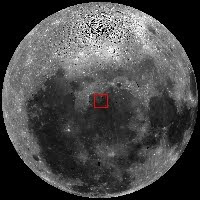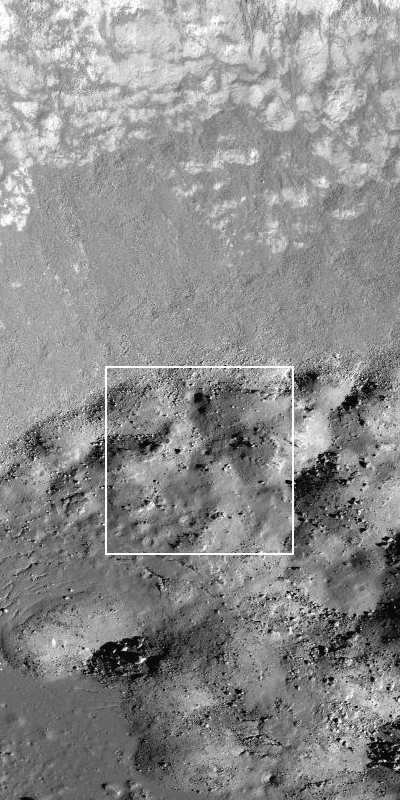Deep interior of Laplace A crater, LROC Narrow Angle Camera (NAC) M129466485R, corrected resolution 0.80 m/pixel, field of view 960 meters; sunlight from southeast, incidence 66° (LRO orbit 4213, May 25, 2010) Full-sized LROC Featured Image HERE [NASA/GSFC/Arizona State University].
 Hiroyuki Sato
Hiroyuki SatoLROC News System
During an impact event the kinetic energy of the meteorite is dissipated by compression, fragmentation, excavation and launching rock debris -- all resulting in an impact crater. The large amount of energy released also melts some of the target rock, and often times impact melt ponds form in the floor of the crater. Since the impact melt is liquid, it seeks an equi-potential level (surface is perpendicular to the gravity vector), thus it is flat and smooth as it freezes.
Today's Featured Image reveals the bottom of Laplace A crater, specifically the north edge of its impact melt pond. The upper side of this image corresponds to the lower part of crater wall, covered by lots of boulders. The surface of this melt pond consists of dozens of low mounds, possibly due to deformation of the pond surface after partial solidification. Perhaps rebound of the crater floor caused the level of molten material beneath the crust to rise and create small breakouts to the surface. There is also a cone shaped depression near these mounds. It may have formed as magma drained out from below?
Today's Featured Image reveals the bottom of Laplace A crater, specifically the north edge of its impact melt pond. The upper side of this image corresponds to the lower part of crater wall, covered by lots of boulders. The surface of this melt pond consists of dozens of low mounds, possibly due to deformation of the pond surface after partial solidification. Perhaps rebound of the crater floor caused the level of molten material beneath the crust to rise and create small breakouts to the surface. There is also a cone shaped depression near these mounds. It may have formed as magma drained out from below?
Inset from full-sized context map (HERE) shows the rich detail of the vicinity of Laplace A, the largest crater in the "mouth" of Sinus Iridium, south of Promontorium Laplace (upper right). LROC Wide Angle Camera (WAC) 100 meter/pixel monochrome global mosaic, overlayed by WAC color Digital Terrain Model (500 m/p). The blue long box over Laplace A corresponds to the footprint of the right-hand frame of LROC NAC M129466485 from which the LROC Featured Image above was derived [NASA/GSFC/Arizona State University].
Explore lunar landslides by viewing the full NAC frame!
The topographic color was produced as a by-product of stereo analysis of the WAC global dataset. Producing the global Digital Elevation Model (DEM) is a big job being led by LROC team members at the German Aerospace Center (DLR; English version) in Berlin.
Related Featured Images:
Impact melt features in Tycho crater's floor
The Floor of Tycho - Constellation ROI
Central Peak of Rutherfurd
More Impact Melt!
General location of the LROC Featured Image, February 24, 2011, within the wider context of the larger width of LROC NAC frame M129466485R [NASA/GSFC/Arizona State University].
It's unfair, really, to seemingly disparage this amazing view as being among the "middle range" of available resolutions in the current harvest from international lunar robotic missions. A 3D view of Laplace A as viewed at or near perilune during a high-priority survey of Sinus Iridium, (possible landing site for China's first lunar lander) from China's second lunar orbiter Chang'E-2, released last October 28, 2010. A larger version of the image is available HERE [CNSA/CLEP].
 |
| From LROC WAC Sample Album |
Inset from uncorrected LROC WAC frame M120026575ME showing Laplace A, swept up during LRO orbit 2822 from an altitude of 36.36 km; resolution 50.92 meters/pixel, February 5, 2010. [NASA/GSFC/Arizona State University].





No comments:
Post a Comment